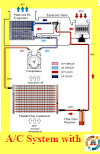Thermal Expansion Block Valve
Thermal Expansion Block Valve
The block valve differs from the previously
mentioned expansion valve in that it has four
passages, although the basic operation is
exactly the same. Operation of the block
valve is still via refrigerant
expansion/contraction within a diaphragm
(11), but not sensed through separate tube
(capillary tube). It is sensed by changes in
the refrigerant temperature and pressure
passing from the evaporator outlet through
the block valve.
As the refrigerant from the outlet side of the
evaporator passes over the sensing element
(12), expansion or contraction of the
refrigerant takes place causing the activating
pin (8) to move the ball valve (6) away or
closer to the metering orifice. This allows
more or less refrigerant to enter the
evaporator coil inlet.
1. From Filter Drier
2. To Evaporator Inlet
3. From Evaporator
4. To Compressor
5. Metering Orifice
6. Ball
7. Spring
8. Activating Pin
9. Refrigerant
10. Pressure Compensation
under Diaphragm
11. Metallic Diaphragm
12. Sensing Element
Pressures in control
As shown in the illustration, the block valve
controls refrigerant flow by using a system of
opposing pressures which we will call:
F1 - Temperature sensing
This is a sealed diaphragm and sensor
containing refrigerant. As refrigerant leaving
the evaporator coil outlet passes over
sensing element (12) the refrigerant (9)
above the diaphragm (11) expands moving
pin (8) downwards pushing ball valve (6)
away from the metering orifice (5).
F2 - Pressure compensation
This is a passage (10) in the block valve
outlet side where refrigerant can build up
under the diaphragm (11) to act as an
opposing pressure to help regulate the
amount of refrigerant into the evaporator coil
inlet side.
F3 - Pressure spring
This spring (7) is located under the ball valve
(6) and acts as an opposing force trying to
move the ball valve towards the metering
orifice (12) and to reduce refrigerant flow to
the evaporator coil inlet.
kandi younes

















0 comments:
إرسال تعليق
ملحوظة: يمكن لأعضاء المدونة فقط إرسال تعليق.